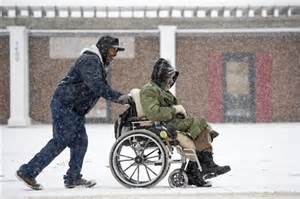
Photo Credit: Automotive Mobility Solutions
Winter Considerations for People With Disabilities
Keep Your Sidewalks Clear
With record-breaking snowfalls, nor’easters and blizzards, Winter 2015 has presented Massachusetts with many challenges – and, winter isn’t over yet.
If we find it hard to get around with 4 foot snow bankings and roads that have yet to see a good melting, imagine the difficulty for someone using a wheelchair.
It is important to keep sidewalks and the ends of your driveways clear if you have a person with a disability living in your community. Whether it’s a traditional or motorized wheelchair, these transportation devices require sidewalks to be cleared wide enough to allow safe travel for wheelchair users.
Winter weather considerations go beyond sidewalk clearing and include important winter safety tips for people with disabilities.
Winter Safety Tips for People With Disabilities
Layer Up
When heading out into the cold weather, dress in layers. Air acts as insulation when it gets trapped between layers. Also, wearing multiple layers offers you the ability to remove layers as you get warm or cool down.
Avoid cotton clothing when possible as it does not dry once wet. Try a moisture-wicking material like polypropylene and other lightweight, man-made fabrics.
Invest in good gloves. Grip driving gloves not only keep your hands warm but also prevent slipping when sleet or ice stick to wheelchairs and other surfaces. Always carry a second pair of gloves with you, in case one pair gets wet.
Use Protection
Use Sunscreen. We never think of it but when the sun’s reflection on the snow can cause sever sunburns.
Another helpful tip is to use Vaseline on exposed areas of your face. It reduces the risk of your face becoming dry or chapped by acting as a moisture insulator.
Getting Around
Using a wheelchair in the snow can be very strenuous. Always take your time and be careful when maneuvering through the snow as the extra exertion could have negative effects on your body.
Don’t Forget Your Four-legged Friend
Dogs can suffer from hypothermia and frostbite, too. If you’re accompanied by a service animal or taking a pet outside, consider a dog coat and boots for their feet. It’s also a good idea to keep a blanket in your vehicle for your pet.
Additional Resources:
http://www.mobilitycorner.com/let-it-snow.html
http://www.accessibleemergencyinfo.com/
http://www.cdc.gov/ncbddd/disabilityandhealth/emergencypreparedness.html
http://emergency.cdc.gov/disasters/winter/index.asp



